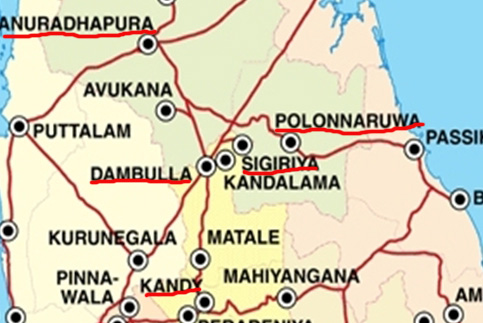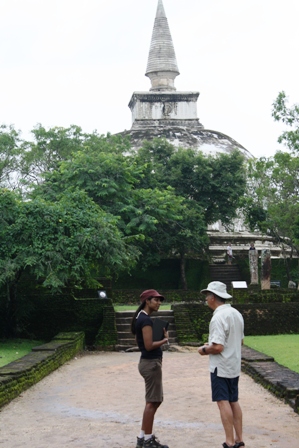Sri Lanka 2013
Episode 9: Polonnaruwa in the Rain

Click the photo above to see an album of photos. Close the window to return to this page
Read Previous Episode 8: Dambulla or Next Episode 10: Anuradhapura|
January 23 2013 Sigiriya, near
Polonnaruwa, Sri
Lanka
We made the right decision today to hire our Guesthouse owner,
Raja, to drive us and be our guide at Polonnaruwa, yet another World
Heritage site. The three of us, Ray and I and our friend
Parmala, set out in cloudy skies to drive 1 ½ hours to the
extensive ruins of a Royal city and Monastery complex. Our first
stop was to the excellent museum where we paid for a day pass
and toured the exhibits to get a better sense of the local
history and why the site is so significant. About 800 or 900
years ago Polonnaruwa was a thriving commercial and religious
center. The rulers and business men erected huge buildings and
beautiful parks, many of which have been explored and repaired
by teams of archaeologists. Polonnaruwa remained the capital of
both the Sinalese and the Indian Chola kingdoms until the early
13th century when power shifted to the western
section of the island.
Another group in the museum at the same time as us were on a bicycle tour of Sri Lanka. Being cyclist ourselves, we stopped to chat and find out how they were coping with the narrow, crowded roads. Most of the cyclist, from the UK and USA, were pleased with the side roads their leaders had chosen for most of their day rides. As we were finishing our tour of the museum, it started to pour rain. We had not had any rain since the beginning of our trip and had no jackets or umbrella with us. Neither did the cycling group. Our guide book, Lonely Planet, had recommended touring Polonnaruwa by bicycle, as the sites are well spread apart. We were glad we had a car and driver for the day. It was raining so hard that everyone just stayed where they were inside the museum until the rain let up and we could join Raja in the car. Raja drove us a short distance to the Royal Group. It had started raining again. There were multiple souvenir salesmen actively promoting their wares, trying to make the most of the few brave souls out in the rain. One man gave Ray an umbrella to use walking around, for a small fee. The two of us shared it while Parmala had one that was in the car. The ruins were most interesting, even viewing them in the rain. There were stone carvings decorating every building and buddhas in shrines. Ponds and baths attested to the builder’s knowledge of water management. Finally the rain let up and we were able to tour the Sacred Quadrangle, a configuration of buildings suggesting a large, active monastery. At the bottom of each set of steps leading to a temple or a palace was a moonstone, an elaborately carved semi-circle of stone. A procession of one animal, an elephant, horse, a lion or a swan made up individual bands surrounding a half-lotus flower carved in the center. The carvings symbolized the steps required to give up worldly desires and obtain nirvana, characterized by the central lotus. Ganas, or dwarf figures could be seen on the risers of steps or flanking the steps leading to the buildings as they were often used as guardians of Royal treasures. As in modern times, Buddhism was a part of daily life and therefore monasteries and temples were amongst the most beautiful buildings. Gal Vihara, our next stop, was a huge rock face carved with beautiful Buddha images. Carved in the 12th century, they were rediscovered in 1820 by a British explorer. Each of the four buddhas was carved to use the maximum size of the stone and each was originally housed in separate chambers. The tallest, a standing Buddha, was 7m tall, the reclining Buddha was 15 m long while the two seated Buddhas were still impressive but a bit smaller. The monastery area contained the remains of temples, residences, assembly hall, a reservoir for fresh water, a crematory, and even a hospital. It was a thriving community. I stayed a bit too long wandering over to a few of the more distant buildings, getting rather wet when finally the rains started again in earnest. Ray stayed in the car while Parmala and I shared an umbrella to visit our last building, an image house with a large, headless Buddha and remnants of beautiful frescoes. It had been a wet but good day. The site is large enough to warrant a two day pass in order to really explore all the buildings Read Previous Episode 8: Dambulla or Next Episode 10: Anuradhapura Read India 2013 Return to Sri Lanka Intro Return to Travels or Introduction |
